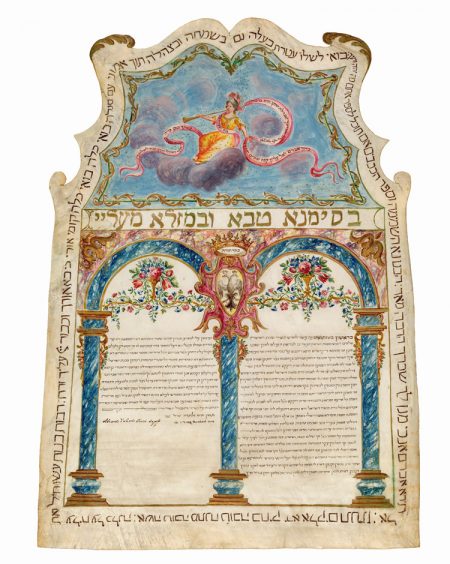Massa di Carrara
VIEW & ZOOMMassa di Carrara
Noted since Roman times for its fine marble quarries, the town of Carrara and its twin, Massa, are located in a Tuscan valley between the sea and the Alps. As Jews worked in both towns, the tiny community that existed there from the sixteenth to the nineteenth century was known as Massa di Carrara. Its name appears in this form in Hebrew documents, including the present ketubbah, which, in all likelihood, is the only illustrated example that survives from this community.
The upper section of the contract is trimmed in an elaborate shape that is remarkably different from the contours created by the makers of all other Italian ketubbot. Luminous watercolors and gold paint create delicate designs. Dominating the lower section is a monumental double arch supported by three columns. They are painted in shades of blue and gold to imitate veins of marble. Clusters of flowers and fruits fill the spaces below the arches. The central column is embellished with an oval cartouche bearing a heraldic device: a crowned double-headed eagle. This emblem, which does not belong to the wedded families, is the official coat of arms of the Hapsburg-Lorraine dynasty that governed Tuscany after 1737. The artist gave the design Jewish meaning by labeling the crown that surmounts the cartouche “Crown of Torah.”
In the upper section, azure heavens are studded with tiny gold stars, symbols of fertility (cf. Genesis 15:5). In the center, seated on gray clouds and dressed in a yellow gown with gold stars, is an angelic-looking young woman. This allegorical figure of Fama (Fame) blows a trumpet to announce the “good name” of the bridal couple. The fluttering red ribbons around her bear biblical inscriptions, allud- ing to the couple and the wedding (Genesis 14:19, 12:2, 24:50; Psalms 128:3). The choice of the blessing on this ribbon to the Patriarch Abram before his name was changed to Abraham, in addition to laudatory verses in honor of Abram along the border (Genesis 15:1, 5), was made because this form of the name is closer to Abramo, the Italian name of the groom.
Massa di Carrara, Sunday, 14 Tishri 5526 (29 September 1765)
Groom: Abraham [Abramo], son of the late Jonathan Judah Finzi
Bride: Ricca, daughter of Gedaliah Senigaglia (Senigallia)
Dowry: 1,800 pezze da ocho reali – of which 1,200 pezze are in cash, 300 in gold jewelry, precious stones and pearls, and 300 in clothing and bed linen; increment: 360 pezze; total obligation: 2,160 pezze
Parchment, 720 × 521 mm (28.3 × 20.5 in.)
Braginsky Collection Ketubbah 70
